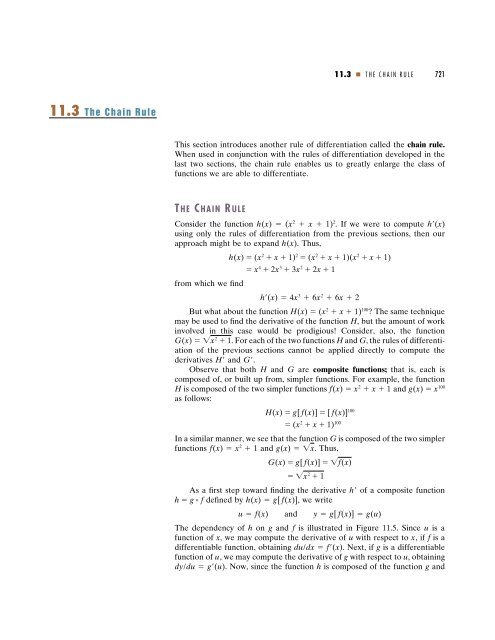11DIFFERENTIATION - Department of Mathematics
11DIFFERENTIATION - Department of Mathematics
11DIFFERENTIATION - Department of Mathematics
Create successful ePaper yourself
Turn your PDF publications into a flip-book with our unique Google optimized e-Paper software.
11.3 The Chain Rule<br />
11.3 THE CHAIN RULE 721<br />
This section introduces another rule <strong>of</strong> differentiation called the chain rule.<br />
When used in conjunction with the rules <strong>of</strong> differentiation developed in the<br />
last two sections, the chain rule enables us to greatly enlarge the class <strong>of</strong><br />
functions we are able to differentiate.<br />
T HE C HAIN R ULE<br />
Consider the function h(x) (x2 x 1) 2 . If we were to compute h(x)<br />
using only the rules <strong>of</strong> differentiation from the previous sections, then our<br />
approach might be to expand h(x). Thus,<br />
h(x) (x2 x 1) 2 (x2 x 1)(x2 x 1)<br />
x4 2x3 3x2 2x 1<br />
from which we find<br />
h(x) 4x3 6x2 6x 2<br />
But what about the function H(x) (x2 x 1) 100 ? The same technique<br />
may be used to find the derivative <strong>of</strong> the function H, but the amount <strong>of</strong> work<br />
involved in this case would be prodigious! Consider, also, the function<br />
G(x) x2 1. For each <strong>of</strong> the two functions H and G, the rules <strong>of</strong> differentiation<br />
<strong>of</strong> the previous sections cannot be applied directly to compute the<br />
derivatives H and G.<br />
Observe that both H and G are composite functions; that is, each is<br />
composed <strong>of</strong>, or built up from, simpler functions. For example, the function<br />
H is composed <strong>of</strong> the two simpler functions f(x) x2 x 1 and g(x) x100 as follows:<br />
H(x) g[ f(x)] [ f(x)] 100<br />
(x 2 x 1) 100<br />
In a similar manner, we see that the function G is composed <strong>of</strong> the two simpler<br />
functions f(x) x2 1 and g(x) x. Thus,<br />
G(x) g[ f(x)] f(x)<br />
x2 1<br />
As a first step toward finding the derivative h <strong>of</strong> a composite function<br />
h g f defined by h(x) g[ f(x)], we write<br />
u f(x) and y g[ f(x)] g(u)<br />
The dependency <strong>of</strong> h on g and f is illustrated in Figure 11.5. Since u is a<br />
function <strong>of</strong> x, we may compute the derivative <strong>of</strong> u with respect to x, iff is a<br />
differentiable function, obtaining du/dx f(x). Next, if g is a differentiable<br />
function <strong>of</strong> u, we may compute the derivative <strong>of</strong> g with respect to u, obtaining<br />
dy/du g(u). Now, since the function h is composed <strong>of</strong> the function g and

















